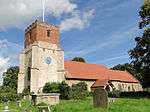Dovercourt
Dovercourt is a small seaside town in the Tendring district, in the county of Essex, England. It is older than its smaller but better-known neighbour, the port of Harwich, and appears in the Domesday Book of 1086. Today the towns are contiguous.
Dovercourt is rich with civil war history and as a seaside resort offers shops and cafes for visitors and residents. The main shopping area is The High Street, with shops from independents to the national chains. The town is served by Dovercourt railway station.
History
The Saxon lord Wulwin/Ulwin was lord in 1066; by 1086 the estate was in possession of Aubrey de Vere I and remained part of the barony of his descendants the Earls of Oxford until the 16th century. It formed part of the dowry of Juliana de Vere when she married Hugh Bigod in the mid-12th century, and the sub-tenancy passed to the Bigod earls of Norfolk who held it as one knight's fee of the Veres. Countess Juliana's son Roger Bigod, 2nd Earl of Norfolk founded a chapel at Harwich and granted it to Colne Priory, Essex, a Vere foundation.[1]
The present town dates back to 1845 when John Bagshaw, an East India merchant, moved to the area and bought the land where Dovercourt now stands. He developed plans to develop a new resort overlooking the sea with the help of W.H. Lindsey, a London architect. He started the project in 1845 by building a mansion, Cliff House, for himself and his family and actively promoted the railway link to the Harwich area. When a chalybeate spring was discovered in the grounds of Cliff House, Bagshaw extended the property to incorporate a spa, library, pump room, and conservatory. He next developed Orwell Terrace where his son Robert John Bagshaw, like his father an MP for Harwich, moved into Banksea House in 1857. However the development project, which included Marine Parade and the Cliff Estate, caused Bagshaw financial difficulties and he was declared bankrupt in 1859. Although Cliffe House was demolished in 1909 and the Spa in 1920, most of his other developments still stand.[2]
In 1863 Trinity House erected two cast iron lighthouses on the beach. They were used until 1917 to guide ships around Landguard Point; the two lights aligned indicated the right course. The deep-water channel is now marked by buoys. The lighthouses were restored in the 1980s.[3] The lighthouses are sometimes known as Dovercourt Range Lights.
The 1980s BBC sitcom Hi-de-Hi! was filmed in Dovercourt, at Warner’s Holiday Camp, which transformed into Maplin’s. The camp, under the direction of Anna Essinger and aided by several of the staff from Bunce Court School,[4][5] had been used in 1939 for refugee children arriving to be placed in foster homes in the Kindertransport mission,[6] and was later re-developed as a housing estate, which is known as Hightrees.
Gallery
 Seafront
Seafront Town Centre
Town Centre Dovercourt beach and lighthouses
Dovercourt beach and lighthouses All Saints' Church, Dovercourt
All Saints' Church, Dovercourt Dovercourt High and Low Lights
Dovercourt High and Low Lights
See also
- John Bagshaw - developer of Dovercourt. MP for Harwich.
- Robert John Bagshaw - son of the above. MP for Harwich
- Hanna Bergas
- Roy Salvadori - winner of 1959 Le Mans 24 hours and Formula One driver
References
| Wikimedia Commons has media related to Dovercourt. |
- Morant, History of Essex, vol. 1, pp. 497-8.
- "Harwich and Dovercourt". Retrieved 14 May 2018.
- "Dovercourt". Harwich & Dovercourt Town Council Official Guide. Local Authority Publishing. Archived from the original on 29 December 2010. Retrieved 31 October 2010.
- Photos and short history of Bunce Court Archived 2011-09-28 at the Wayback Machine Town of Faversham website. "Bunce Court, Otterden" Retrieved September 28, 2011
- "Refugee Children in Britain: Testimony of Hanna Bergas" Archived 2012-04-15 at the Wayback Machine Yad Vashem History of the Holocaust.org Retrieved October 7, 2011
- Cox, Murray (23 November 2008). "'We lived on hope and promises'". BBC News. BBC. Retrieved 23 November 2008.
